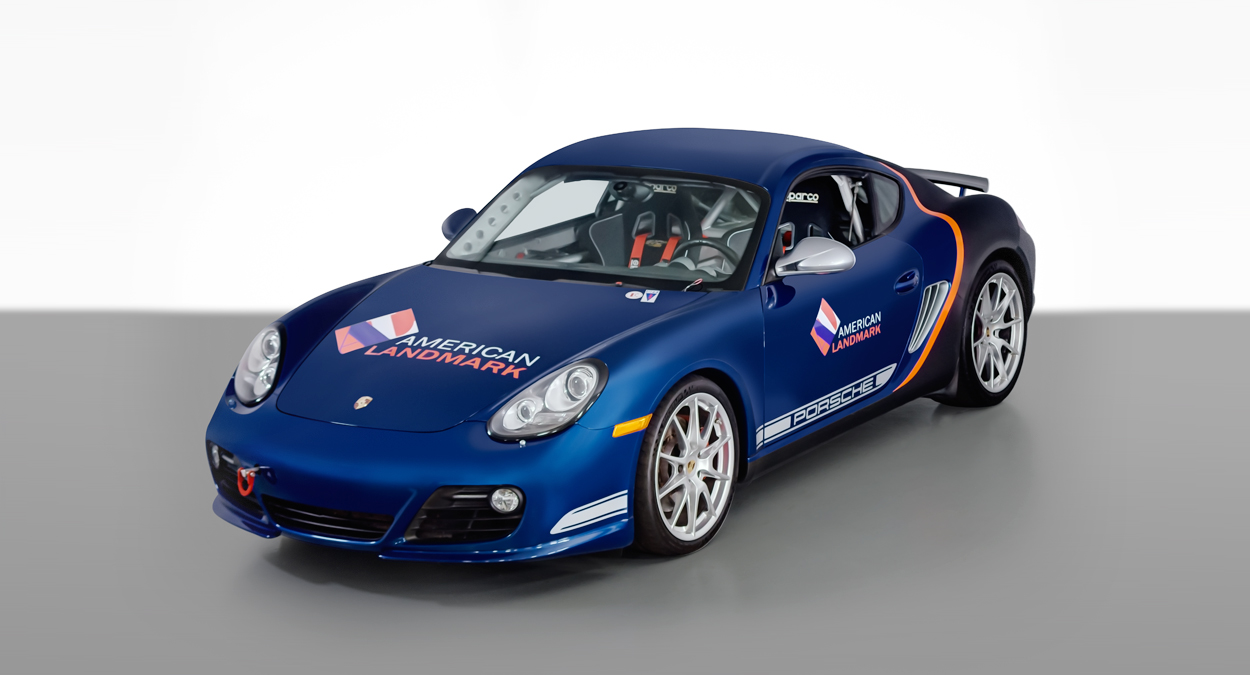

2012 Porsche Cayman
Click any photo to view fullscreen. Mobile users can pinch to zoom. Tap ‘X’ to close.
SPEED
SPECIFICATIONS
- Mileage – Unknown
- Race Car Modifications By Brumos Racing of Jacksonville FL
- 3.4l H6 Engine DOHC 24 Valve
- Doppelkupplungsgetriebeseven-speed dual-clutch automatic
- Custom Roll Cage
- Custom Fire systems
- Custom Seat sliders and Brackets
- 5 Point Harness System
Porsche Cayman Track Car 2012
he 2012 Porsche Cayman carries over mostly unchanged from the previous edition. New for 2012 are two more powerful variants in the Cayman lineup: the bare-bones, race-inspired Cayman R and the luxe, feature-packed Cayman S Black Edition. Both use the same 3.4-liter flat-6 found in the Cayman S, tuned to make ten extra ponies for a total of 330 horsepower.
Like all Porsche models, the interior and exterior options on the Cayman are configurable in thousands of combinations, so exclusivity with any one individual car is well within reach.
The Cayman coupe is related to the Boxster convertible, and some will argue that the Cayman is merely a fixed-roof version of the Boxster. Not so. The Cayman has its own feel and character. It can serve as a luxury grand-touring car for two with heated and ventilated leather seats, Bose sound system, and navigation system. But it’s also a sports car with superb driving dynamics, wonderful sounds, and excellent driver involvement. Two cargo areas and fair gas mileage make for a decent daily driver, while adjustable suspension, advanced drivetrain, and racing-style brakes are well-suited for the track.
The Cayman looks the road-going equivalent of a race car, which should be no surprise given Porsche’s success on the world’s racetracks. The overall impression is a shape designed to most efficiently cover the working parts and two people.
The hood, front fenders and doors are similar to those on the Boxster, but the remaining bodywork is different. Some refer to the Cayman as a Boxster hardtop but this in inaccurate on many counts, both cosmetic and mechanical, and therefore unfair to either car. They have different missions and appeal, illustrated perhaps best by Porsche offering a fixed hardtop for the Boxster.
A Cayman somewhat resembles the animal it shares a name with (a crocodilian reptile), especially in the tail that slopes down below the hips formed by the rear fenders. From the head of the windshield the top surface nearly duplicates a droplet, the low-drag aerodynamic shape found in everything from blimps to dry-lake speed cars. You could run a straightedge from the top of the rear window to the rear spoiler and barely fit a thumb under it, the sides protected with ridges to direct airflow and stiffen the hatch frame.
Aerodynamically, the Cayman is a slippery car. The least aerodynamic model, the Cayman S with PDK, has a coefficient of drag of 0.30 and less than two square meters of frontal area. A rear spoiler ahead of the back-bumper breaks airflow to keep the car on the ground, and at 75 mph the spoiler rises for increased stability in high-speed turns.
Physics and the ergonomics of car control define the Cayman interior, the basic design unchanged in racing Porsches save removal of the various amenities, carpeting and air conditioning, and addition of a roll cage and seat harnesses. The driver faces a three-pod instrument panel dominated by an 8000-rpm tachometer with inset message and digital speed display. A compact speedometer is on the left, coolant and fuel level to the right, with the bottom segment of each relegated to information displays. On PDK cars the gear display is in the right dial.
Porsche’s new double-clutch PDK gearbox is the alternative, with a wider overall ratio spread across the seven speeds but always one available for maximum thrust. This is a sophisticated box that will run fully automatically or under full manual control. You have to learn how to best get it in motion, both forward and backward. Tight parking maneuvers are a bit more challenging, and it really isn’t built for idle-speed creeping. But it delivers extremely fast gear changes with no brutality. It also rates a few miles per gallon higher on the highway cycle, though any Cayman delivers good fuel economy for a car with this level of acceleration and top speed.
A worthwhile option is the limited-sip differential. The Cayman doesn’t have serious issues getting its power to the ground, yet for optimum performance there is always a choice.
About the size of a personal pizza, the brake discs don’t look that big, especially lurking inside a 19-inch wheel, until you realize the typical 2,900-pound car has brakes more the size of a dessert plate. Cross-drilled, vented and equipped with multi-piston calipers, the brakes are magnificent: Pedal reaction is instant, braking force directly related to how hard you push the pedal, fade non-existent, and stops short and stable with minimal nose-dive and the rear stays flat. Credit not only the brakes but the low, rearward weight bias and sticky tires. Note that all Caymans have the same diameter brakes but the S gets red-painted calipers. They are among the best in the world and take many pounds of unsprung weight off the front end, but unless you have 19-inch wheels and frequently drive on track, the performance of the standard brakes is the envy of most motorcars.
Response is quick and predictable, the relatively thin-rimmed wheel telling your hands all you need to know and nothing you don’t. Effort is never so light you’ll be palming the wheel in complete turns and never so heavy you feel like you’re working hard.
With the structural stiffness enabled by the presence of the fixed roof, the Cayman is very rigid. There’s no flex or twist to speak of, so the shock and spring rates can be kept firm without upsetting the occupants and roll stiffness keeps the car balanced while letting each wheel do its own work. The addition of Porsche’s adjustable shock damping (PASM) allows the comfort for everyday or rougher road use with the taut suspension desired on a track and lowers the ride height; you will need a fairly smooth public road to find yourself going noticeably quicker with Porsche Active Suspension Management set in Sport mode.
Locating the engine, the heaviest part in the car, in the middle and down low results in a low center of gravity, and this means transitional response is superb (changing direction left to right or acceleration to deceleration, for example). Not only do the performance tires deliver considerable grip for ultimate cornering speed, on winding roads you feel only a fraction of the level of weight transfer typical of lesser cars.





